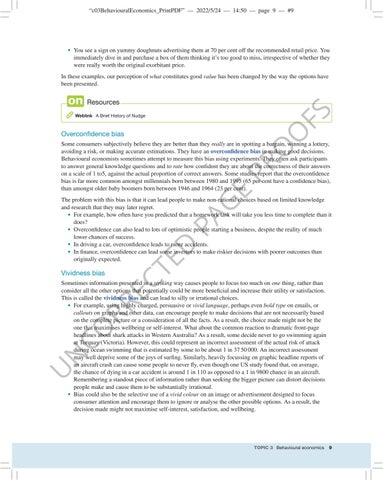“c03BehaviouralEconomics_PrintPDF” — 2022/5/24 — 14:50 — page 9 — #9
• You see a sign on yummy doughnuts advertising them at 70 per cent off the recommended retail price. You
immediately dive in and purchase a box of them thinking it’s too good to miss, irrespective of whether they were really worth the original exorbitant price. In these examples, our perception of what constitutes good value has been changed by the way the options have been presented.
Resources
FS
Resourceseses
O
Weblink A Brief History of Nudge
Overconfidence bias
E
PR
O
Some consumers subjectively believe they are better than they really are in spotting a bargain, winning a lottery, avoiding a risk, or making accurate estimations. They have an overconfidence bias in making good decisions. Behavioural economists sometimes attempt to measure this bias using experiments. They often ask participants to answer general knowledge questions and to rate how confident they are about the correctness of their answers on a scale of 1 to5, against the actual proportion of correct answers. Some studies report that the overconfidence bias is far more common amongst millennials born between 1980 and 1995 (65 per cent have a confidence bias), than amongst older baby boomers born between 1946 and 1964 (23 per cent).
CO RR EC
Vividness bias
TE
D
PA
G
The problem with this bias is that it can lead people to make non-rational choices based on limited knowledge and research that they may later regret. • For example, how often have you predicted that a homework task will take you less time to complete than it does? • Overconfidence can also lead to lots of optimistic people starting a business, despite the reality of much lower chances of success. • In driving a car, overconfidence leads to more accidents. • In finance, overconfidence can lead some investors to make riskier decisions with poorer outcomes than originally expected.
U
N
Sometimes information presented in a striking way causes people to focus too much on one thing, rather than consider all the other options that potentially could be more beneficial and increase their utility or satisfaction. This is called the vividness bias and can lead to silly or irrational choices. • For example, using highly charged, persuasive or vivid language, perhaps even bold type on emails, or callouts on graphs and other data, can encourage people to make decisions that are not necessarily based on the complete picture or a consideration of all the facts. As a result, the choice made might not be the one that maximises wellbeing or self-interest. What about the common reaction to dramatic front-page headlines about shark attacks in Western Australia? As a result, some decide never to go swimming again at Torquay (Victoria). However, this could represent an incorrect assessment of the actual risk of attack during ocean swimming that is estimated by some to be about 1 in 37 50 000. An incorrect assessment may well deprive some of the joys of surfing. Similarly, heavily focussing on graphic headline reports of an aircraft crash can cause some people to never fly, even though one US study found that, on average, the chance of dying in a car accident is around 1 in 110 as opposed to a 1 in 9800 chance in an aircraft. Remembering a standout piece of information rather than seeking the bigger picture can distort decisions people make and cause them to be substantially irrational. • Bias could also be the selective use of a vivid colour on an image or advertisement designed to focus consumer attention and encourage them to ignore or analyse the other possible options. As a result, the decision made might not maximise self-interest, satisfaction, and wellbeing.
TOPIC 3 Behavioural economics
9





















































